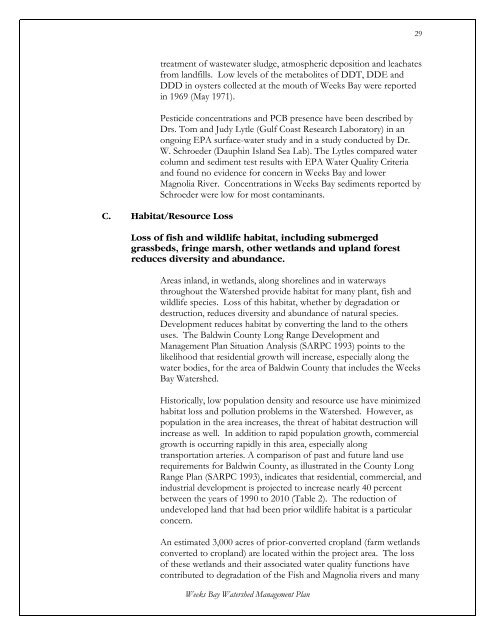Weeks Bay Watershed Project Management Plan - Mobile Bay ...
Weeks Bay Watershed Project Management Plan - Mobile Bay ...
Weeks Bay Watershed Project Management Plan - Mobile Bay ...
You also want an ePaper? Increase the reach of your titles
YUMPU automatically turns print PDFs into web optimized ePapers that Google loves.
29<br />
treatment of wastewater sludge, atmospheric deposition and leachates<br />
from landfills. Low levels of the metabolites of DDT, DDE and<br />
DDD in oysters collected at the mouth of <strong>Weeks</strong> <strong>Bay</strong> were reported<br />
in 1969 (May 1971).<br />
Pesticide concentrations and PCB presence have been described by<br />
Drs. Tom and Judy Lytle (Gulf Coast Research Laboratory) in an<br />
ongoing EPA surface-water study and in a study conducted by Dr.<br />
W. Schroeder (Dauphin Island Sea Lab). The Lytles compared water<br />
column and sediment test results with EPA Water Quality Criteria<br />
and found no evidence for concern in <strong>Weeks</strong> <strong>Bay</strong> and lower<br />
Magnolia River. Concentrations in <strong>Weeks</strong> <strong>Bay</strong> sediments reported by<br />
Schroeder were low for most contaminants.<br />
C. Habitat/Resource Loss<br />
Loss of fish and wildlife habitat, including submerged<br />
grassbeds, fringe marsh, other wetlands and upland forest<br />
reduces diversity and abundance.<br />
Areas inland, in wetlands, along shorelines and in waterways<br />
throughout the <strong>Watershed</strong> provide habitat for many plant, fish and<br />
wildlife species. Loss of this habitat, whether by degradation or<br />
destruction, reduces diversity and abundance of natural species.<br />
Development reduces habitat by converting the land to the others<br />
uses. The Baldwin County Long Range Development and<br />
<strong>Management</strong> <strong>Plan</strong> Situation Analysis (SARPC 1993) points to the<br />
likelihood that residential growth will increase, especially along the<br />
water bodies, for the area of Baldwin County that includes the <strong>Weeks</strong><br />
<strong>Bay</strong> <strong>Watershed</strong>.<br />
Historically, low population density and resource use have minimized<br />
habitat loss and pollution problems in the <strong>Watershed</strong>. However, as<br />
population in the area increases, the threat of habitat destruction will<br />
increase as well. In addition to rapid population growth, commercial<br />
growth is occurring rapidly in this area, especially along<br />
transportation arteries. A comparison of past and future land use<br />
requirements for Baldwin County, as illustrated in the County Long<br />
Range <strong>Plan</strong> (SARPC 1993), indicates that residential, commercial, and<br />
industrial development is projected to increase nearly 40 percent<br />
between the years of 1990 to 2010 (Table 2). The reduction of<br />
undeveloped land that had been prior wildlife habitat is a particular<br />
concern.<br />
An estimated 3,000 acres of prior-converted cropland (farm wetlands<br />
converted to cropland) are located within the project area. The loss<br />
of these wetlands and their associated water quality functions have<br />
contributed to degradation of the Fish and Magnolia rivers and many<br />
<strong>Weeks</strong> <strong>Bay</strong> <strong>Watershed</strong> <strong>Management</strong> <strong>Plan</strong>
















